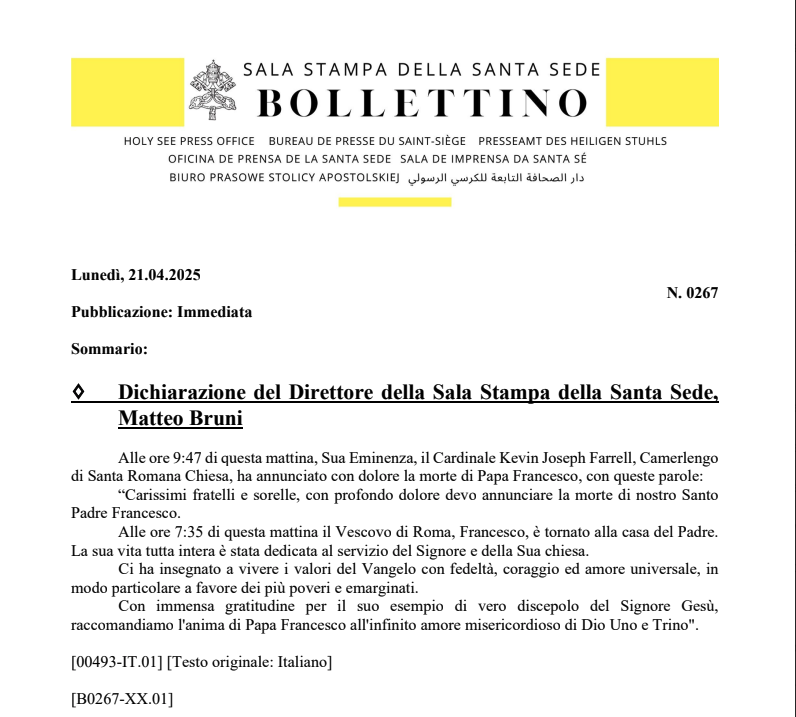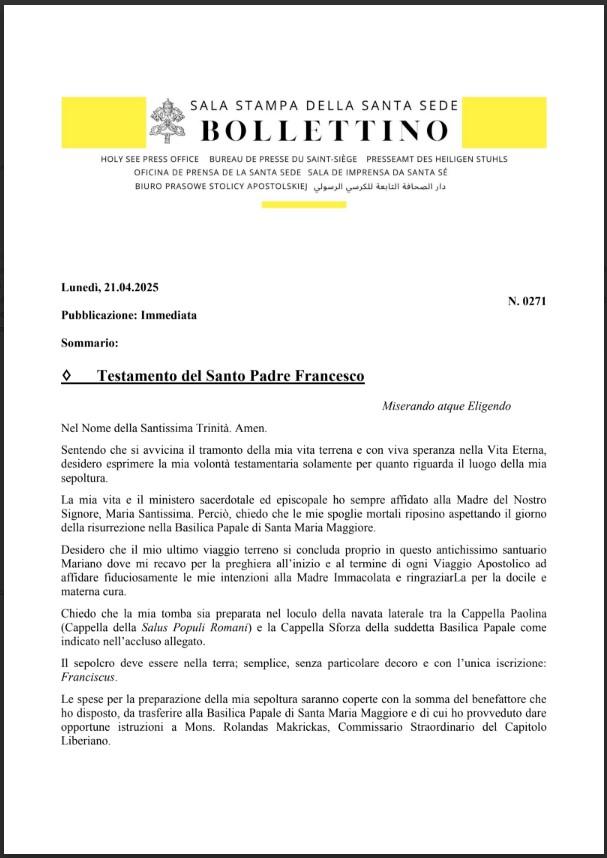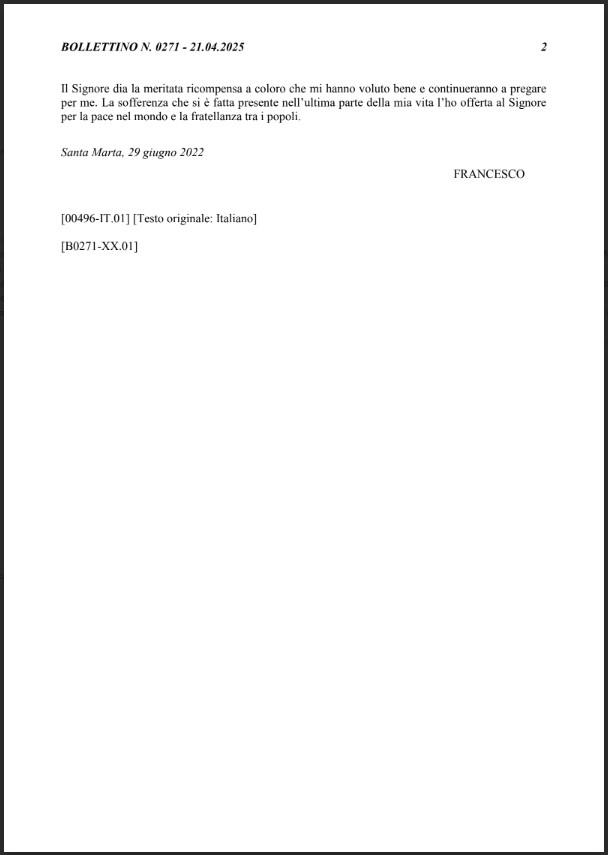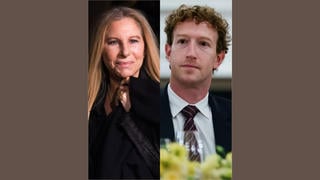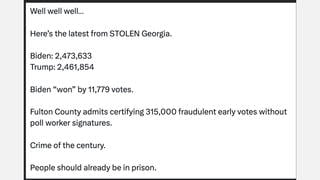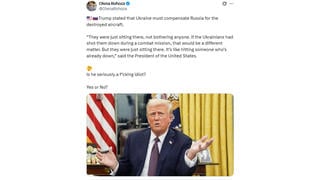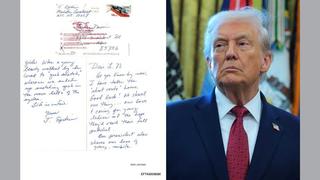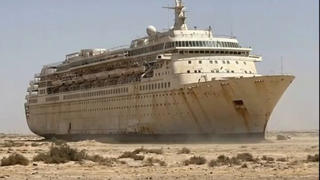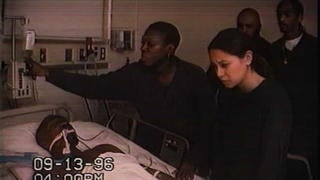STORY UPDATED: check for updates below.

By Raffaella Menichini, Lead Stories Deputy International Teams Manager (Rome) and Lead Stories staff
A nine-day mourning period has begun with the death of Pope Francis, who died on Monday, April 21, 2025, at the age of 88, according to a statement released by the Holy See Press Office. The cause of death, declared by the Vatican's Directorate of Health and Hygiene, was stroke, coma and irreversible cardiovascular collapse.
"Dearest brothers and sisters, with deep sorrow I must announce the death of our Holy Father Francis. At 7:35 this morning, the Bishop of Rome, Francis, returned to the house of the Father," Cardinal Kevin Ferrell said in the statement, which was released at 9:47 a.m. CEST.
"His entire life was dedicated to the service of the Lord and His Church. He taught us to live the values of the Gospel with fidelity, courage, and universal love, especially in favor of the poorest and most marginalized," the statement said.
"With immense gratitude for his example as a true disciple of the Lord Jesus, we commend the soul of Pope Francis to the infinite merciful love of the One and Triune God."
The official announcement of Pope Francis' death released by the Holy See Press Office.
Francis had been battling pneumonia. He was admitted to Agostino Gemelli Polyclinic Hospital in Rome on February 14, 2025, for a respiratory crisis that developed into double pneumonia. He spent 38 days there, the longest hospitalization of his 12-year papacy.
His death came less than 24 hours after he blessed thousands of people who gathered for Easter Sunday mass in St. Peter's Square, during which he passed a text to be read by Archbishop Diego Ravelli, the Master of Pontifical Liturgical Celebrations. He later surprised the public by traveling in the Popemobile through St. Peter's Square, where crowds cheered "Viva il Papa!" ("Cheers to the Pope!")
Official cause of death:
Prof. Andrea Arcangeli, Director of the Vatican's health and hygiene directorate, wrote in a report released by the Holy See Press Office and translated to English by Lead Stories staff in Rome, that Pope Francis, born Jorge Mario Bergoglio, died at 7:35 a.m. CET in his apartment at the Domus Santa Marta (Vatican City).
Arcangeli's report said he was affected by:
- Previous episode of acute respiratory failure in bilateral multimicrobial pneumonia - Multiple bronchiectases
- Arterial hypertension
- Diabetes type II
Arcangeli wrote that death was verified using a electrocardiotanatographic recording, also known as an ECG or EKG. The Holy See Press Office's release on his report appears below:
(Source: Holy See Press Office official press release screenshot by Lead Stories.)
Last Testament:
As translated to English by Lead Stories staff in Rome, Pope Francis' last testament reads as follows:
Testament of the Holy Father Francis
...
Feeling that the sunset of my earthly life is approaching and with lively hope in Eternal Life, I wish to express my testamentary will only with regard to the place of my burial.
My priestly and episcopal life and ministry, I have always entrusted to the Mother of Our Lord, Mary Most Holy. Therefore, I ask that my mortal remains rest waiting for the day of resurrection in the Papal Basilica of St. Mary Major.
I wish my last earthly journey to end in this very ancient Marian shrine where I used to go for prayer at the beginning and end of each Apostolic Journey to entrust my intentions to the Immaculate Mother and thank Her for her docile and maternal care.
I request that my tomb be prepared in the niche in the aisle between the Pauline Chapel (Chapel of the Salus Populi Romani) and the Sforza Chapel of the aforementioned Papal Basilica as indicated in the enclosed attachment.
The tomb is to be in the earth; simple, without special decoration and with the only inscription: Franciscus.
The expenses for the preparation of my burial shall be covered by the benefactor's sum which I have arranged, to be transferred to the Papal Basilica of St. Mary Major and of which I have arranged to give appropriate instructions to Msgr. Rolandas Makrickas, Extraordinary Commissioner of the Liberian Chapter.May the Lord give the deserved reward to those who have loved me and will continue to pray for me. The suffering that became present in the last part of my life, I offered it to the Lord for world peace and brotherhood among peoples.
Santa Marta, June 29, 2022
FRANCIS
The Holy See Press Office released Pope Francis' Last Testament in a press release as follows:
Meeting with U.S. Vice President:
Francis also met briefly on Easter Sunday with U.S. Vice President J.D. Vance. The Vatican said the two met in a reception room of the Vatican hotel, where the pontiff lived.
"I know you have not been feeling great, but it's good to see you in better health," Vance told the pope, according to video footage of the meeting. "Thank you for seeing me."
Francis was hospitalized in February, according to Vatican News, the official news portal for the Vatican and the Holy See. An extended stay at the hospital revealed he was suffering from double pneumonia. In a press conference on Friday, February 21, covered widely by mainstream media, his doctors confirmed he was not yet out of danger but expected to live. While it was later reported that he was in stable condition, he suffered two respiratory attacks by Monday, March 3, said the Holy See Press Office, adding that while the Pope remained alert and cooperative at all time, "the prognosis remains guarded."
The Pope's poor health prompted false claims on social media that he was using a body double. The false claim used two photos of the Pope taken 10 years apart, a Lead Stories debunk found.
Biographical Facts:
- Pope Francis was born Jorge Bergoglio on December 17, 1936, in Buenos Aires, Argentina.
- He was ordained as a priest on December 13, 1969.
- His papacy began on March 13, 2013, following the retirement of Pope Benedict XVI.
- First non-European pope of the modern era.
- First pope to take the name of St. Francis of Assisi, who has been revered among Catholics for his work with the poor. St. Francis was viewed as a church reformer.
- First Jesuit to become pope.
Facts about Pope's Health:
According to the National Catholic Reporter, Francis relied on Vatican priests to read longer addresses during the past month.
Francis suffered two falls while getting out of his bed at his Vatican residence - once in December and once in January, the NCR reported, citing the Vatican.
He was hospitalized four times after he became Pope. His last hospitalization in February 2024 was related to respiratory issues, according to Vatican news archives. He also was hospitalized in 2023 for bronchitis and in 2021 when he had a portion of his intestine removed.
In 1957, Francis underwent a partial lobectomy after suffering a severe respiratory infection.
What Happens Next:
Pope Francis requested that his funeral rites be simplified and focus on expressing the faith of the Church in the Risen Body of Christ, Archbishop Diego Ravelli told The Vatican News.
Francis' coffin will lie in state in the Vatican City for private viewing, before being moved to St. Peter's Basilica for public viewing. Francis' coffin may be transferred to the basilica on Wednesday, April 23, Matteo Bruni, the director of the Holy See Press Office, said in answer to journalists' questions, according to an email from the Vatican press office.
The mourning period is nine days, and thousands are expected to pay their respects. A funeral mass will take place in St. Peter's Basilica or the Square.
Unlike previous pontiffs, Pope Francis said he wanted to be buried in the Papal Basilica of Saint Mary Major, also known as Santa Maria Maggiore -- one of the four major papal basilicas.
The Conclave:
The Conclave is expected to begin weeks after Francis' death. The Conclave takes place in the Sistine Chapel and the cardinal electors are prohibited from communicating with the outside world. They have no access to news, and their phones and electronic devices are taken from them.
Smoke from the Sistine Chapel signals the progress of the Conclave. Black smoke after a vote signals no pope has been selected. White smoke signals a new pope. Approximately 15-30 minutes after the white smoke appears, the doors of the central balcony of St. Peter's Basilica open, and the cardinal deacon briefly announces that there is a new pope.
Previous fact checks
Previous fact checks from Lead Stories involving Pope Francis can be found here.
Updates:
-
2025-04-21T19:40:12Z 2025-04-21T19:40:12Z Update: Adds Last Testament of Pope Francis, directing where he'll be buried and markings on his grave. -
2025-04-21T19:09:55Z 2025-04-21T19:09:55Z Update: Adds cause of death report from Vatican Directorate for Health and Hygiene. -
2025-04-21T12:48:42Z 2025-04-21T12:48:42Z Update: Adds details about the transfer of the Pope's body -
2025-04-21T12:03:39Z 2025-04-21T12:03:39Z Update: Adds material about what happens, changes headline. -
2025-04-21T11:38:38Z 2025-04-21T11:38:38Z Update: Deletes outdated material. Adds new details about the funeral, conclave. -
2025-04-21T10:58:18Z 2025-04-21T10:58:18Z Update: Changes headline. -
2025-04-21T09:26:04Z 2025-04-21T09:26:04Z Update: Adds details about previous hospitalizations. -
2025-04-21T08:45:20Z 2025-04-21T08:45:20Z Update: Adds details about Pope Francis' Easter message and meeting with U.S. Vice President J.D. Vance.

